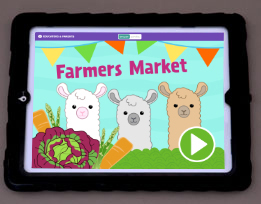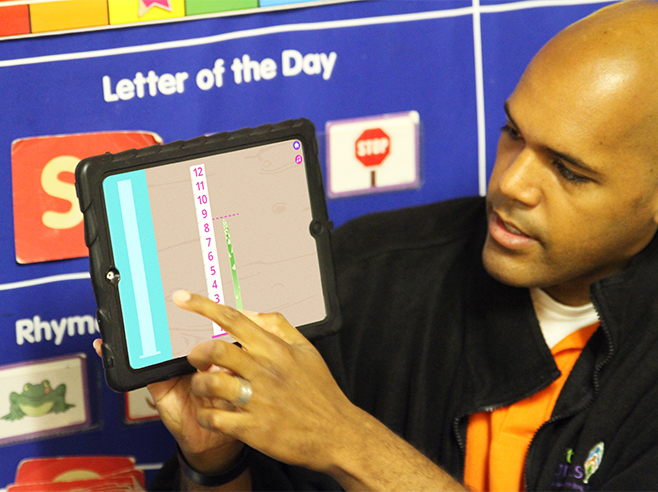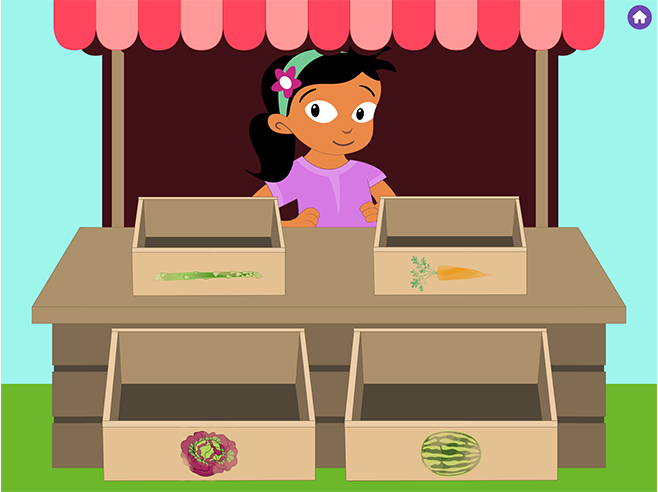Children visit a digital farmers market and explore measuring plants for their llama customers. Children harvest the plants, position a measuring stick, and measure how tall or wide each plant is to find the right size for every customer.
Materials

- Farmers Market app on iPads (1 device for Circle Time; 2–4 for Learning Centers)
- Projector (if available)
Preparation
- Familiarize yourself with the Farmers Market app. Play through the four fruit and vegetable choices on your own.
- If you prefer to use the app without music during parts of the game, tap the pink “music” button to mute all music.
- Note: As children work through the Farmers Market app, they are challenged to align a measuring stick in the correct position in order to measure the height and width of different fruits and vegetables.
- Lesson 3: Asparagus and Carrot. Introduces measuring the height of different-sized asparagus and carrots. Children learn to align the measuring stick with the bottom of the asparagus/carrot and measure up to the top of the vegetable. They count the number of units to determine the height of each vegetable.
- Lesson 4: Lettuce and Watermelon. Introduces measuring the width of different-sized lettuces and watermelons. Children learn to align the measuring stick with one side of the vegetable or fruit and measure across to the other side of the object. They count the number of units to determine the width of each vegetable or fruit.
Directions: Lesson 3
Circle Time: Introduction
This game is introduced in a whole-group activity. Use a projector or hold the iPad as you would a picture book for the group to see. Children will also explore the game independently at the Learning Center and review explorations during the Wrap-Up activity.
Introduce the game using the asparagus plant. Listen to the app audio and ask selected children to follow the prompts. Engage the group in a conversation, using science and math discussion prompts such as those below to continue exploring.
- Hold up the app and read the title to introduce the Farmers Market game. Find out what children know about farmers markets.
- Has anyone ever been to a farmers market? Tell us about it.
- What things did you see at the farmers market?
- Point out the fruits and vegetables shown on the screen. Can you name any of these fruits and vegetables? Did you see any of these at the farmers market?
- Tap the green play button to continue. Listen to Nor introduce the app.
- Point out the boxes on the table. What fruits and vegetables will we need to harvest?
- You might need to explain that “harvesting” is done at the time of year when the fruits and vegetables on the farm are fully grown and ready to be picked and gathered from the trees and fields.
- Asparagus and Carrot. Tell children they will be harvesting different-sized asparagus and carrot plants today and then measuring how tall the plants have grown.
- Ask a volunteer to tap on the asparagus box. Once the garden appears, listen to Nor’s instructions. Then help the child place a finger on one of the asparagus stalks and drag it into the basket.
- Have children count the asparagus stalks as the volunteer places each one in the basket.
- How many asparagus did we harvest?
- Tell children they will measure all the asparagus plants to see how tall each one has grown.
- Point to the pulsing measuring stick. Count each number on the stick with children. Explain that they will use the measuring stick to find how tall each asparagus stalk has grown.
- Explain how to begin measuring height: line up the bottom of a measuring stick with the bottom of the plant.
- Notice how the pink lines at the bottom of the measuring stick and bottom of the plant line up.
- Why do you think we need to line up the bottom of the measuring stick with the bottom of the plant to start measuring?
- Could we find out how tall it is if we started measuring from the middle of the plant? Why or why not?
- Place a finger on the measuring stick and point out the pink dotted line that appears. Invite a child to drag the measuring stick inside the pink dotted line.
- Point out how the number 1 is at the bottom of the asparagus.
- If children try to align the measuring stick incorrectly, it will bounce back to the blue column. If they are really close to aligning it, however, it will snap into place.
- Let’s measure! Have the child tap the number 1 on the measuring stick.
- What happens when (child’s name) touches the number 1? Each time a finger moves onto a number, a circle will appear around the number. This tells you how many units you have measured.
- As the child moves her/his finger up the measuring stick, say: You have to go to the top of the plant to measure the height of the whole plant.
- Have the class count aloud the numbers on the measuring stick as each one is highlighted.
- When the child stops measuring, have her or him tap the pink “llama” button.
- If the child measured too far or not far enough, Nor will instruct him or her to keep measuring.
- You may want to point out the visual clues on the screen: 1) The pink circled number that shows how many units of the plant you have measured so far. 2) The blue area behind the asparagus that appears when you touch a number within the size range of the plant. Measure until the whole asparagus is in the blue area. 3) The pulsing pink dotted line that appears if you push the llama button but have not measured to the top of the plant or have measured too far. Do you need more or fewer units to reach the pink line?
- Tell children they can push the llama button anytime they need help.
- Repeat with the remaining two asparagus plants. Have volunteers help you align the measuring stick and measure the plants.
- After the plants are measured, the llama customers appear. Invite volunteers who have not had a chance to use the app to help you give the customers the correct-sized asparagus stalk.
- How many units tall does the asparagus need to be for this customer? Point to the number tag if children are unsure.
- Have children count as you point to each number on the measuring stick. Have them clap when it is time to stop counting—at 8 units.
- How many units tall is it?
- When you have reached 8 units, ask a volunteer to find the asparagus stalk that is 8 units tall and drag it over to the llama. Continue with the remaining two stalks.
- Great job! You gave all the llamas the right-sized asparagus. Listen to them all crunching happily on their asparagus!
- Tell children they will be able to work with a partner harvesting and measuring more asparagus and carrots in the Learning Center.
Learning Center
- Encourage children to listen to and build on each other’s ideas as they explore the Farmers Market game in pairs or individually. Observe how children approach each round of the game, and use prompts such as those used during the whole-group explorations to engage children in science and math talk.
- Support children in thinking about cause and effect as they solve each challenge, noting how some plants grow tall and others grow wide over time. Discuss how the same types of plants can grow to be different shapes and sizes.
- Have you ever eaten a short carrot? A tall carrot?
- Have you ever seen a small watermelon? A big watermelon?
- Support children in thinking about how plants grow and change over time.
- What are some things these plants needed to help them grow big enough to be harvested?
Circle Time: Wrap-Up
This activity reviews the app measuring explorations children experienced earlier in the Circle Time and Learning Center activities.
- Hold up the app. Tap the green play button to continue. Listen to Nor introduce the app.
- Invite children to describe their earlier explorations as they take turns harvesting and measuring plants.
- Encourage children to listen to and support one another when they get stuck or are unsure how to harvest or measure.
- As children walk through and describe their explorations, open a discussion to elicit understanding of how to align the measuring stick and measure the plants. Possible discussion ideas:
- How did you harvest the vegetables? How many (asparagus/carrots) did you harvest?
- What part of the (asparagus/carrot) do you line up with the measuring stick? Why?
- What clues do you see on the screen that help you measure the whole plant?
- How many customers want (asparagus/carrots)? How many (asparagus/carrots) do you have?
- How many units tall is the biggest (asparagus/carrot)?
Directions: Lesson 4
Circle Time: Introduction
The Farmers Market game is introduced during Circle Time. The instructions for Lesson 4 are similar to those for Lesson 3 but are focused on harvesting lettuce and watermelon and measuring width.
Use a projector or hold the iPad as you would a picture book for the group to see. Children will also explore measuring width at the Learning Center and during the Circle Time: Wrap-Up activity.
Listen to Nor introduce the app again and invite children to follow the prompts. Engage the group in a conversation, using science and math discussion prompts. Possible discussion ideas:
- Review what children know about farmers markets.
- Lettuce and Watermelon. Point to the lettuce and watermelon boxes on the screen. Can you name these plants? Tap on one of the boxes.
- Tell children they will continue to harvest the lettuce and watermelon plants, but they will be measuring how wide these plants have grown.
- What did we measure when we measured the asparagus and carrots?
- Once the garden appears, listen to Nor’s instructions. Then invite a volunteer to drag the (lettuce/watermelon) into the basket.
- Have children count the (lettuce/watermelon) as the child places each one in the basket. How many did we harvest?
- Let’s measure! Point to the pulsing measuring stick. What is different about how the measuring stick appears now from when we measured the asparagus and carrots?
- Count each number on the stick with children. Explain that they will use the measuring stick to measure the width of each (lettuce/watermelon).
- How did we line up the measuring stick with the plant to measure height for the asparagus and carrots the last time?
- Explain that when measuring width, the measuring stick goes across the plant, from one side of the plant to the other.
- Notice how the pink lines at the side of the measuring stick and the side of the plant line up.
- Could we find out how wide the whole lettuce is if we started measuring from the middle of the plant? Why or why not?
- Place a finger on the measuring stick and point out the pink dotted line that appears. Invite a child to drag the measuring stick inside the pink dotted line.
- Point out how the number 1 is now lined up with one side of the (lettuce/watermelon).
- If children try to align the measuring stick incorrectly, it will bounce back to the blue column.
- Let’s measure! Have the child tap the number 1 on the measuring stick.
- What happens when (child’s name) touches the number 1? As a finger moves over the number, a circle will appear. This tells you how many units you have measured.
- Point out the blue area that appears behind the (lettuce/watermelon) each time you touch a number. The blue area only appears when you touch a number that is within the width range of the plant.
- Have the child move a finger slowly across the measuring stick. As the finger moves across the measuring stick, say: You have to go to the other side of the plant to measure the width of the whole plant.
- Have the class count aloud the circled numbers as each one is highlighted.
- When the child stops measuring, have her or him tap the pink llama button.
- If the child measured too far or not far enough, Nor will instruct her or him to keep measuring.
- Before the child continues, you may want to point out the visual clues on the screen: 1) the pink circled number that shows how many units of the plant you have measured so far, 2) the blue area behind the (lettuce/watermelon) that appears when you touch a number that is within the size range of the plant, and 3) the pulsing pink dotted line that appears if you push the llama button but have not measured to the top of the (lettuce/watermelon) or have measured too far.
- Tell children that they can press the pink llama button anytime they need help.
- Repeat with the remaining two (lettuce/watermelon) plants. Invite volunteers to help you align the measuring stick and measure the plants.
- After the plants are measured, the llama customers appear. Have volunteers who have not had a chance to use the app help give the customers the correct-sized (lettuce/watermelon).
- How many units wide is the (lettuce/watermelon)? Which customer needs a (lettuce/watermelon) this wide? Point to the number tag if children are unsure.
- Ask children to count as you point to each number on the measuring stick. Have them clap when it is time to stop counting.
- Have a volunteer find the (lettuce/watermelon) that is the width the customer needs. Then drag it over to the llama. Continue with the remaining two (lettuce/watermelon) plants.
- Great job! You gave all the llamas the right-sized (lettuce/watermelon). Listen to them all crunching happily on their (lettuce/watermelon)!
- Tell children they will be able to work with a partner harvesting and measuring more fruits and vegetables in the Learning Center.
Learning Center
- Encourage children to listen to and build on each other’s ideas as they explore the Farmers Market game in pairs or individually. Observe how children approach each round of the game, and use prompts such as those used during the whole-group explorations to engage children in science and math talk.
- Support children in thinking about cause and effect as they solve each challenge, noting how some plants grow tall and others grow wide over time. Discuss how the same types of plants can grow to be different shapes and sizes.
- Have you ever seen a small watermelon? A big watermelon?
- Have you ever eaten a short carrot? A tall carrot?
- Support children in thinking about how plants grow and change over time.
- What are some things these plants needed to help them grow big enough to be harvested?
Circle Time: Wrap-Up
This activity gives children the opportunity to review the app measuring explorations they experienced earlier in the Circle Time and Learning Center activities.
- Hold up the app and read the title to introduce the Farmers Market game. Tap the green play button to continue. Listen to Nor introduce the app.
- Invite children to describe their earlier explorations as they take turns harvesting and measuring plants.
- Encourage children to listen to and support one another when they get stuck or are unsure how to harvest or measure.
- As children walk through and describe their explorations, open a discussion to elicit understanding of how to measure. Possible discussion ideas:
- How did you harvest the fruits and vegetables? How many (lettuce/watermelon) did you harvest?
- What part of the (lettuce/watermelon) should you line up with the measuring stick? Why?
- What clues do you see on the screen that will help you measure the width of the whole plant?
- How do you know you measured the width of the whole plant?
- How many customers want (lettuce/watermelon)?
- How many units wide is the biggest (lettuce/watermelon)?


